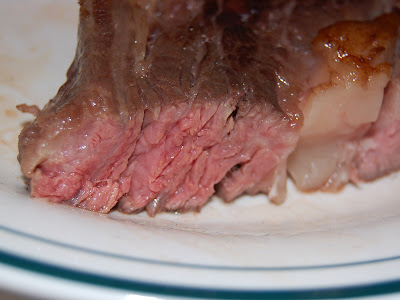 It's been a while since I did something crazy in the kitchen, so Friday night I decided to switch up the old steak routine and attempt sous vide at home. For those of you unfamiliar with the technique, it's basically poaching an ingredient sealed in plastic at a low temperature for a long period of time. A more refined version of "boil in the bag", popular at cafeterias worldwide.
It's been a while since I did something crazy in the kitchen, so Friday night I decided to switch up the old steak routine and attempt sous vide at home. For those of you unfamiliar with the technique, it's basically poaching an ingredient sealed in plastic at a low temperature for a long period of time. A more refined version of "boil in the bag", popular at cafeterias worldwide. I'm hardly breaking new ground here, as many bloggers have experimented with various ingredients and techniques. After a perusal of the literature, I took a pair of ribeyes and put them in Ziploc Freezer Bags with just a dash of sea salt and Worcestershire sauce. (These bags are rated to 170°F, but in general you're only supposed to do this with specially designed plastic. And there's chances of all sorts of bacterial horrors, so kids, don't try this at home.) I had three gallons of water sitting at 140°F for about an hour learning how to regulate the temperature--with the inset strainer, I was able to stand up the bags and prevent them from touching the hot bottom of the pot. I used a digital probe thermometer to monitor the water temperature, and through use of adjusting the knob and adding ice cubes, I was able to keep the temp pretty close to my target.
 The steaks sat in the bath for about two hours, were allowed to rest, and then I seared them in a very hot skillet. Just long enough to brown the exterior, not to do any actual cooking. At right you can see a close-up after I cut into the steak: it's a nice medium rare, even throughout. The biggest surprise was that it had the soft texture and buttery fat of prime rib, which is difficult to achieve with a single steak. It was very tasty, but I wouldn't recommend the method for everyday use. While fun from a science project standpoint, it's a lot of work to keep the temperature right and it takes forever. Professional kitchens fond of sous vide have industrial water baths that circulate the water, use thermostats, and can tie in microprobes to get the internal temperature of the ingredients.
The steaks sat in the bath for about two hours, were allowed to rest, and then I seared them in a very hot skillet. Just long enough to brown the exterior, not to do any actual cooking. At right you can see a close-up after I cut into the steak: it's a nice medium rare, even throughout. The biggest surprise was that it had the soft texture and buttery fat of prime rib, which is difficult to achieve with a single steak. It was very tasty, but I wouldn't recommend the method for everyday use. While fun from a science project standpoint, it's a lot of work to keep the temperature right and it takes forever. Professional kitchens fond of sous vide have industrial water baths that circulate the water, use thermostats, and can tie in microprobes to get the internal temperature of the ingredients.If you want to play with this yourself, just search Google and you'll find lots of home kitchen experiments. Again, there are some dangers, and you want to be careful with your plastic selections. I'm not suggesting you try it, and the FDA has been against it for years, only recently allowing it under certain very strict conditions.
 For the wine I decanted a bottle of the 2004 Sawyer Cellars Estate Bradford Meritage from Napa Valley, California. 52% Cabernet Sauvignon 31% Merlot, 4% Cabernet Franc, 13% Petit Verdot. $44, less than 1000 cases made. Cherry and plum aromas with a touch of fennel. Medium tannins, and as the flavor opened up, it displayed notes of bell pepper and black tea. It's obviously delicious now, but could definitely hang around for a few more years.
For the wine I decanted a bottle of the 2004 Sawyer Cellars Estate Bradford Meritage from Napa Valley, California. 52% Cabernet Sauvignon 31% Merlot, 4% Cabernet Franc, 13% Petit Verdot. $44, less than 1000 cases made. Cherry and plum aromas with a touch of fennel. Medium tannins, and as the flavor opened up, it displayed notes of bell pepper and black tea. It's obviously delicious now, but could definitely hang around for a few more years. Through a combination of luck and generosity I've had a good bit of Napa wine recently, and after trekking the tastebuds through every obscure corner of the wine world it's nice to step back and study some serious, well-made wines in the classical tradition.

2 comments:
Sous Vide?! Dude, you are hard core. You must be a very patient person. I agree about the comfort of the classics, discovery is tremendous fun but sometimes you just want that warm, long hug feeling you can get with the classics. For me it is Burgundy, with a glass of Burgundy in my hand I can let that "Where should I put this" thing in my brain shut off and just savor the wine.
Samantha,
I've made demi-glace from scratch, and there was a Sauce Robert recipe that took two days... I've taken the night shift on roasting a whole hog that cooked for 18 hours. While these things are fun every now and then, it's not something I'd want to do all the time.
I agree with you on Burgundy, particularly on the white side. If you ever get bored with Chardonnay, a proper, well-aged white Burgundy at the right temperature is like getting a massage.
Post a Comment